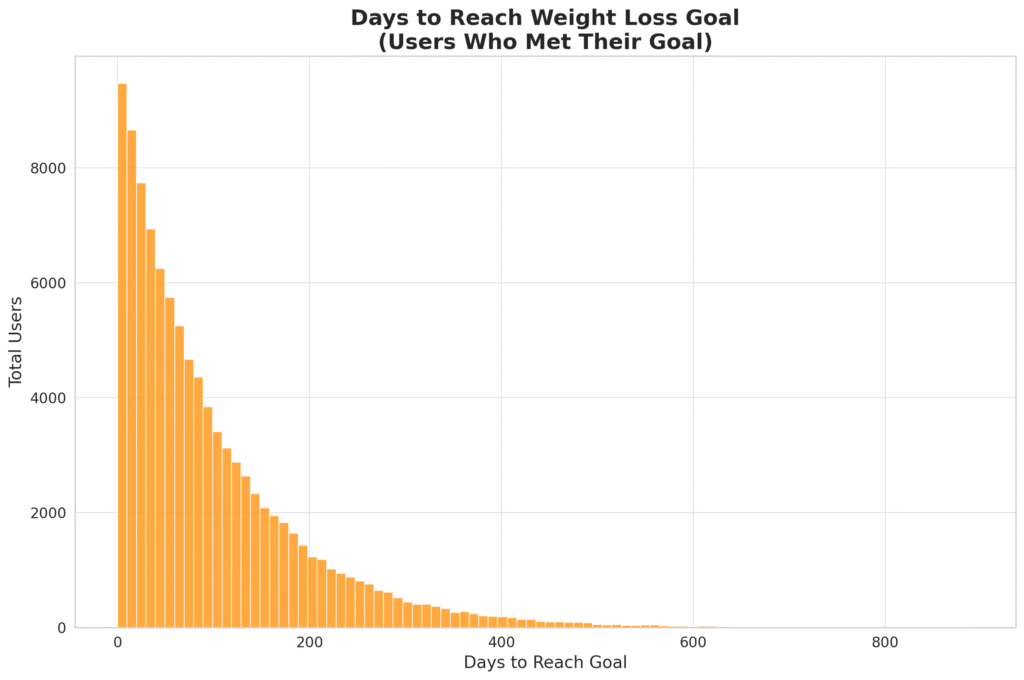


Losing weight doesn’t have to feel like guesswork anymore. Our science-based weight loss calculator takes all the confusion out of calorie counting by giving you a personalized daily calorie target that’s designed specifically for your body.
Whether you want to lose 10 pounds or 50, this calculator uses proven nutritional science. It actually figures out how many calories a person should intake each day to reach their target weight safely and effectively. We’ve developed this tool with input from registered dietitians and based it on established metabolic research, so you get recommendations that are both realistic and sustainable.
What you’ll get:
The calculator recommends that a woman should take 1200 calories and 1,500 for men to ensure you’re getting adequate nutrition while losing weight. We strongly recommend to consult with a professional while starting your weight loss journey. This is necessary if you have any health issue.
Using our weight loss calculator is straightforward and takes less than two minutes. Here’s what you need to do:
You’ll need to input your current weight, height, age, and biological sex. Make sure to weigh yourself at the same time of day for the most accurate reading – preferably in the morning after using the bathroom but before eating or drinking.
a realistic target weight that falls within a healthy range for your height. If you’re unsure what’s healthy for you, the CDC provides body mass index (BMI) guidelines that can help you determine an appropriate goal.
Be honest about your current activity level. The calculator uses these categories:
Select when you’d like to reach your goal weight. Remember, the calculator will adjust your daily calorie needs based on how quickly you want to lose weight, but it won’t recommend unsafe calorie levels.
Your results will show your recommended daily calorie intake to achieve your goal weight by your target date. If the calculator suggests a calorie level below safe minimums, it will automatically adjust your timeline to ensure healthy weight loss.
The foundation of weight loss is creating a calorie deficit, which means eating fewer calories than your body burns each day. But how many calories does your body actually need?
Your body burns calories in three main ways:
1: Basal Metabolic Rate (BMR): It’s actually that energy which your body uses for their basic body function including breathing, circulation, and maintaining organ function. BMR typically accounts for 60-70% of your total daily calorie burn.
2: Physical Activity: This includes both planned exercise and everyday activities including walk, physical work etc. Physical activity can account for 15-30% of your daily calorie burn, depending on how active you are.
3: Thermic Effect of Food: Your body burns calories digesting and processing food, accounting for about 8-10% of your total daily calorie needs.
The U.S. Department of Agriculture estimates that women typically need 1,600 to 2,400 calories in a day to maintain her weight. It shows that men need 2,000 to 3,000 calories per day. These ranges vary significantly based on age, size, and activity level.
Several factors influence the calories your body needs in a day. Understanding these factors helps explain why two people of the same weight might have different calorie needs.
Your current weight significantly impacts your daily calorie needs. Larger bodies require more energy to maintain basic functions and to move through daily activities. When you lose weight, your calorie needs is lower down. Which is why many people need to adjust their calorie intake during their weight loss journey.
Age affects your metabolism in several ways. As we get older, we typically lose muscle mass, become less active, and experience hormonal changes that can slow our metabolism. Men typically have larger body frames and more muscle mass than women, which increases their calorie requirements.
Taller people generally need more calories than shorter people because they have more body mass to maintain. Your body composition also matters like your muscle tissue actually needs more calories than fat tissues at rest level. Therefore people with more muscle mass actually needs higher calories.
Your activity level has a significant impact on your daily calorie needs. Be honest when selecting your activity level, as many people overestimate how active they are, which can lead to calorie recommendations that are too high for effective weight loss.
Setting realistic goals is one of the most important factors in successful weight loss. Unrealistic expectations often lead to frustration, extreme behaviors, and ultimately, giving up on your goals entirely.
The Centers for Disease Control and Prevention (CDC) recommends that 1-2 pounds weight loss in a week is safe, sustainable weight loss. This rate allows you to lose weight while maintaining muscle mass, keeping your metabolism relatively stable, and developing healthy habits that will serve you long-term.
When you understand why gradual weight loss works better, you’re more likely to stick with it. If you cut calories too drastically, your metabolism slows down to conserve energy, you’re more likely to lose muscle mass along with fat, and you may experience fatigue and difficulty concentrating. People who lose weight slowly are much more likely to keep it off long-term.
Instead of picking an arbitrary number, try these approaches:

While creating a calorie deficit is the fundamental principle of weight loss, the quality of your diet matters significantly for your health, energy levels, and ability to stick to your goals.
Even when eating fewer calories, your body still needs adequate nutrition to function properly:
Some foods make it easier to stick to your calorie goals:
Exercise plays an important but often misunderstood role in weight loss. While diet is typically the primary driver of weight loss, physical activity provides numerous health benefits and can support your weight loss efforts.
Many people overestimate how many calories they burn during exercise. A 30-minute brisk walk might burn 150-200 calories, which is roughly equivalent to a small snack. This is why you can’t out-exercise a bad diet, but exercise becomes increasingly important for maintaining weight loss long-term.
You shouldn’t go to a gym to increase your activity level:
The best exercise is the one you’ll actually do consistently, so experiment with different activities to find what you enjoy.
Tracking your progress is crucial for successful weight loss, but it’s important to monitor more than just the number on the scale.
People who monitor their weight loss efforts are more successful than those who don’t. Self-monitoring helps you stay accountable, identify patterns, recognize progress even when the scale doesn’t budge, and make informed adjustments to your approach.
The scale only tells part of your story. Other important indicators include energy levels, sleep quality, mood and mental clarity, how your clothes fit, and improvements in physical capabilities like endurance or strength.
Almost everyone faces obstacles during their weight loss journey, and when you understand these challenges as well as strategies to overcome them, you can stay on track toward your goals.
Weight loss plateaus are frustrating but completely normal. They occur when your weight loss stalls for several weeks despite maintaining your calorie deficit. If you’ve hit a plateau, try reassessing your calorie needs with your current weight, tightening up your food tracking, increasing physical activity, or varying your routine.
If you find issues with your emotional eating, you have to learn the ways to manage your emotions and stress. Common triggers include work stress, boredom, social situations, fatigue, or anxiety. Develop non-food coping strategies like taking walks, calling friends, or practicing deep breathing.
Motivation naturally fluctuates during a weight loss journey. Find your personal “why” by identifying specific reasons you want to lose weight, share your goals with supportive people, celebrate small wins and non-scale victories, and remember that motivation isn’t constant – rely on healthy habits during low-motivation periods.
Your body needs a minimum number of calories each day to function properly. For women, the general minimum is 1,200 calories per day, and for men, it’s 1,500 calories per day. However, individual needs can vary.
Speak with a doctor or registered dietitian before starting a weight loss program if you have existing medical conditions, a history of eating disorders, need to lose a significant amount of weight, are pregnant or breastfeeding, or take medications that might be affected by dietary changes.
Seek medical attention if you experience extreme fatigue, dizziness, rapid weight loss of more than 2-3 pounds per week consistently, obsessive thoughts about food, or inability to concentrate that interferes with daily life.
Start small with one or two key habits initially, be consistent rather than perfect, practice self-compassion when you have setbacks, celebrate your progress, and stay flexible by adjusting your approach based on what you learn about yourself.
Remember that weight loss is a journey, not a destination. The habits you develop during this process will serve you for life, so focus on changes you can maintain long-term rather than quick fixes that won’t last.
If you’re ready to start your weight loss journey but aren’t sure how many calories you should be eating, our weight loss calculator can provide you with a personalized daily calorie target based on your individual information. Use this calculator as one helpful tool in your overall weight loss approach, alongside a balanced diet rich in nutritious foods and regular physical activity.
While the calculator provides estimates based on the basic information you enter, remember that individual results may vary due to factors like metabolism, medical conditions, and lifestyle differences. If you find it difficult to understand your results or need guidance on how to achieve your weight loss goals safely and effectively, we strongly recommend consulting with a registered dietitian or your healthcare provider who can provide personalized advice tailored to your specific needs.
This weight loss calculator and information are for educational purposes only and are not intended to replace professional medical advice. Always consult with qualified healthcare professionals before beginning any weight loss program, especially if you have medical conditions or special circumstances.
How accurate is the weight loss calculator?
Weight loss calculators provide estimates based on established formulas, but individual results can vary due to factors like genetics, metabolism, and medical conditions. Use the calculator as a starting point and be prepared to make adjustments based on your real-world progress.
Can I eat whatever I want as long as I stay within my calorie goal?
While you can lose weight by staying within your calorie limit regardless of food choices, the quality of your diet affects your health, energy levels, and satisfaction. Foods high in protein, fiber, and nutrients will help you feel fuller and more energized than processed foods or sweets.
Is it normal for my weight to fluctuate daily?
Yes, daily weight fluctuations of 1-4 pounds are completely normal and don’t reflect changes in body fat. Water retention, food in your digestive system, hormonal changes, and sodium intake all affect daily weight. Focus on the overall trend over weeks rather than daily changes.
How do I handle social situations and eating out?
Plan ahead by looking at restaurant menus online and choosing options that fit your calorie goals. Consider eating a small, protein-rich snack before social events to avoid arriving overly hungry. Remember that occasional indulgences won’t derail your progress if you get back on track with your next meal.